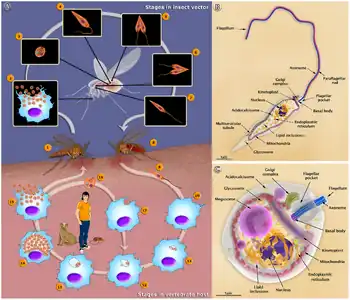Leishmania amazonensis
Lua error in Module:Autotaxobox at line 156: attempt to index a nil value.
| Leishmania amazonensis | |
|---|---|
| Scientific classification | |
| Species: | [[Template:Taxonomy/Template:Speciesbox/getGenus]]Template:Taxon italics |
| Binomial name | |
| [[Template:Taxonomy/Template:Speciesbox/getGenus]]Template:Taxon italics Lainson & Shaw, 1972 | |
Template:Speciesbox/parameterCheck
Leishmania amazonensis is a parasite responsible for the disease leishmaniasis. This species has been known to spread by using sandflies as its vector and a vertebrate as its primary host, just like other species of Leishmania.[1] They have also been known to spread throughout the Brazilian Amazon region due to their ecological niches needed for survival and reproduction. However, when the host is infected, the Leishmania can cause 3 different forms of Leishmaniasis. For this species, it has been known to cause cutaneous leishmaniasis and mucocutaneous leishmaniasis. Cutaneous leishmaniasis is commonly characterized with skin lesions, which can appear localized, or throughout the body. While mucocutaneous leishmaniasis is characterized with ulcers around the skin, mouth, and nose. This form of Leishmaniasis has also been known to can spread by metastasis and can be deadly.[2]

References
- ↑ Prevention, CDC - Centers for Disease Control and (18 February 2020). "CDC - Leishmaniasis - Biology". Archived from the original on 4 October 2018. Retrieved 20 May 2023.
- ↑ Prevention, CDC - Centers for Disease Control and (17 March 2023). "CDC - Leishmaniasis - Resources for Health Professionals". Archived from the original on 7 March 2015. Retrieved 20 May 2023.